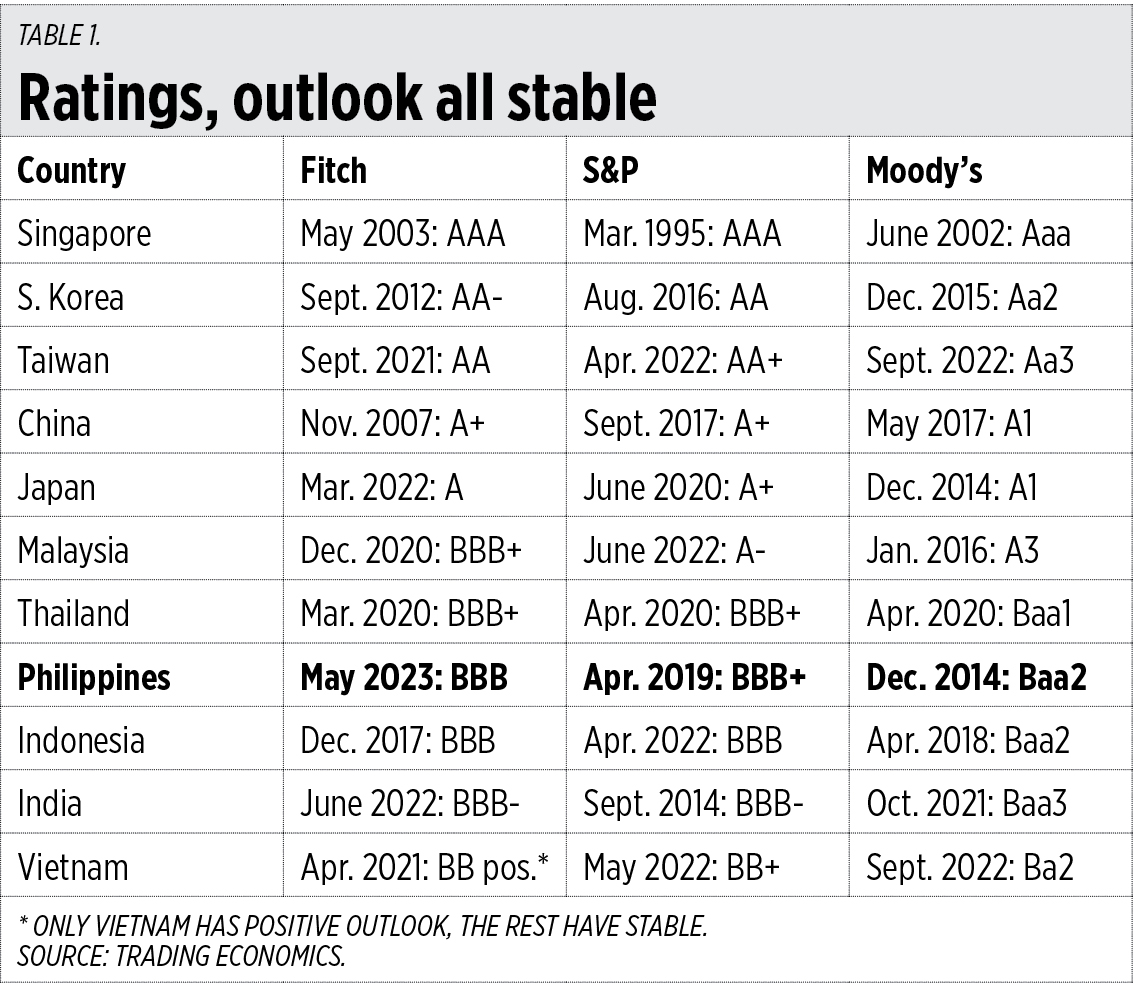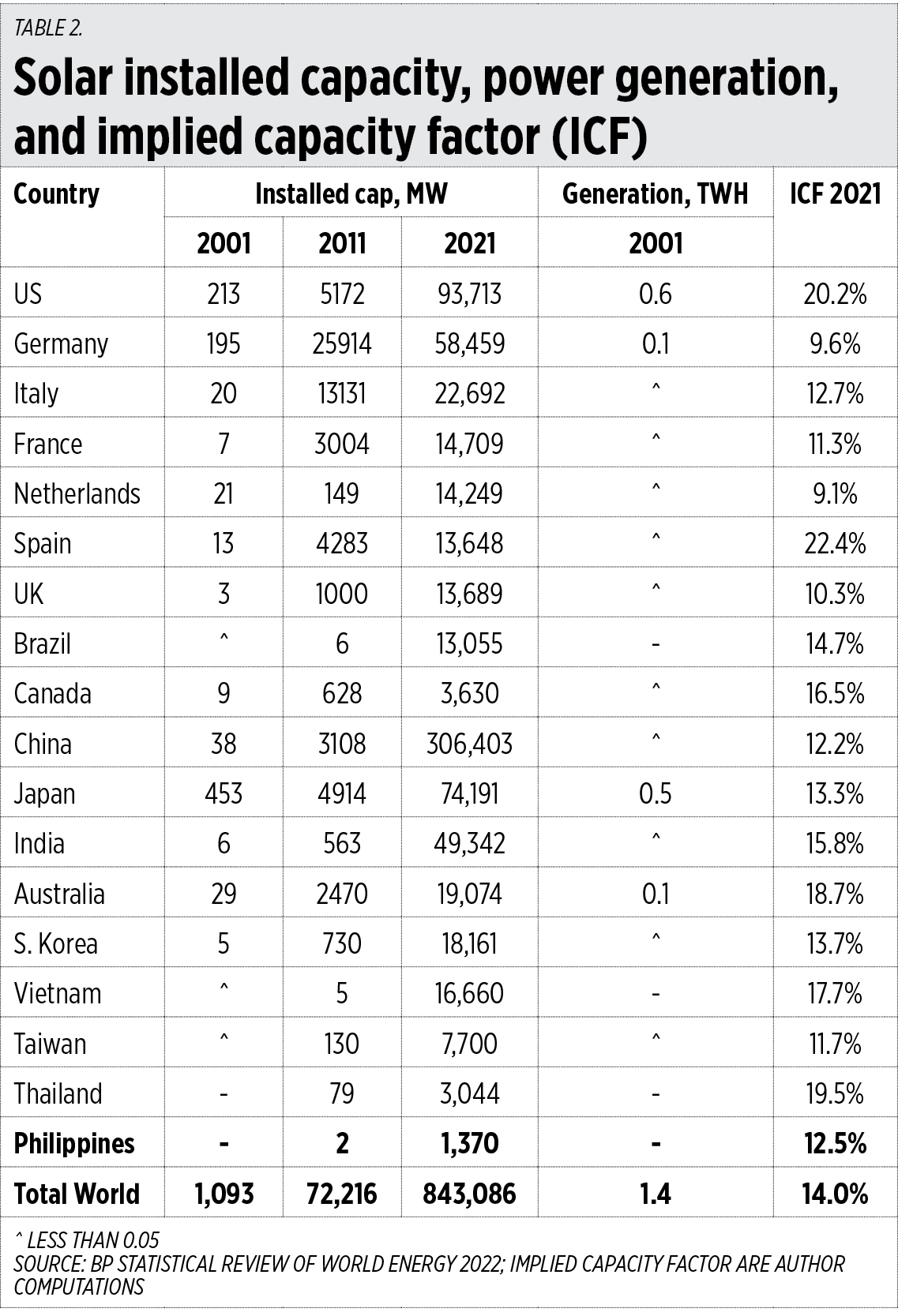Last Monday, there was good news — the Fitch upgrade of its outlook on the Philippines from “negative” to “stable.” The Philippines’ rating remains at “BBB” which is considered “investment grade” and above the “speculative grade” of “BB” to “D.” A rating of BBB means the risk of loan default is low and is a vote of confidence that the country’s ability to pay its financial obligations is high.
Finance Secretary Benjamin Diokno commented: “The improved outlook for the Philippines to ‘stable’ is a testament to the country’s robust macroeconomic fundamentals, as evidenced by the economy’s strong growth performance in 2022 at 7.6% and 6.4% in the first quarter of 2023.”
Budget Secretary Amenah Pangandaman said: “Fitch’s improved outlook is a welcome development leading to the attainment of our fiscal consolidation goals and the achievement of more fiscal space for the government’s priority agenda and projects.”
So far, so good.
Table 1 shows the comparative ratings of selected Asian economies from the top ratings agencies in the world. The Philippines is at par with Indonesia in Fitch ratings but higher than it in S&P ratings. It is also higher than India and Vietnam.
Congratulations, Philippine entrepreneurs, investors, consumers, and the government economic team.
ENERGY ISSUES
The National Grid Corp. of the Philippines (NGCP) has recently been on the hot seat in the eyes of the public, government regulators, and legislature. See these recent reports in BusinessWorld: “NGCP warns RE intermittency could pose grid integration issues” (May 14), “Gov’t may retake control of NGCP” (May 14), “NGCP confident of hurdling proposed audit of operations” (May 18), “DoE expects NGCP audit to start this year” (May 21), “Senate probe sought on delays in NGCP projects” (May 21).
The trigger was the series of yellow and red alerts and rotating blackouts in the Luzon-Visayas grids, the latest being on May 8. The NGCP’s PR guys tried to spin the event as due to failing power plants when the reality was its transmission line in Zambales tripped, affected a big power plant there which took many hours to restore. Its spin was caught by the public and the legislature, especially the Senate.
In other developments, see also these recent reports about solar and wind energy in BusinessWorld: “Six floating solar contracts issued for construction on Laguna de Bay” (May 10), “Higher auction floor price sought for floating solar” (May 11), “ETM seen helping PHL accelerate transition to clean energy” (May 16), “DoE issues rules to expedite offshore wind energy projects” (May 19).
Since solar hates shade — from clouds, rain, trees — it is an intermittent and problematic energy source. Solar developers cut and murder all trees nearby because of the trees’ shade that can reduce solar output. Or large agricultural land is converted, so we see many rice fields, sugar fields, cornfields, etc. that have been converted to solar farms. Solar is the most anti-trees, anti-green energy technology.
I checked data on solar capacity and generation by country and computed the implied capacity factor or percentage of installed capacity that actually generates electricity. After many decades of subsidies and favoritism given to solar (and wind), the capacity factor remains low. In 2021, there was a maximum of 22% (Spain) and as low as 9% (Netherlands), with an average of 14% worldwide. Meaning that on average, solar produces 28% at daytime, zero at night, for an average of 14% worldwide. The Philippines has only 12.5% or below the world average (See Table 2). This could be due to the frequent cloudy, rainy days in the country that year.
We have to sustain growth. We have to further improve our investment environment and attractiveness. We have to create more jobs and businesses, reduce people’s dependence on government for welfare and subsidies. In the process, we have to reduce the need for more borrowing and taxes.
Our energy policies should not compete with more agriculture production, more forest protection. There are moves now to develop solar farms in lakes and dams. This should be fine but the impact on the marine environment as sunlight is prevented from reaching below the water’s surface does not seem to have been studied well.
Wind capacity factors and related issues will be discussed in future columns.
Bienvenido S. Oplas, Jr. is the president of Bienvenido S. Oplas, Jr. Research Consultancy Services, and Minimal Government Thinkers
Philippines ratings upgrade, energy policies to sustain growth
Source: Bantay Radio


0 Comments